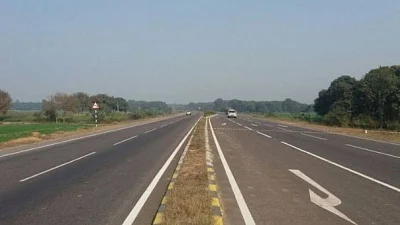Awarding of national highway contracts to be hit with Bharatmala Phase I stretching on, says study
A CRISIL report says that the delay could defer NHAI awards under Bharatmala Phase 1 beyond fiscal 2024 — the year construction was originally scheduled to be completed

Contrary to what Union Minister for Surface Transport and Highways Nitin Gadkari might say, the rolling out of national highways contracts under Bharatmala Phase I in the country may slow down to 5,000 km annually, breaking a four-year streak amid a limited rise in budgetary support, coupled with a higher CAPEX for 70% of high-value expressways currently under construction, as per a latest study report released on Friday.
This slowdown in awarding of the contracts could extend over this fiscal and the next.
Data analyzed by CRISIL indicates that the National Highways Authority of India (NHAI) reported a sequential rise in awarding contracts from merely 2,222 km in fiscal 2019 to 6,306 km in fiscal 2022.
The CRISIL report says that the delay could defer NHAI awards under Bharatmala Phase 1 beyond fiscal 2024 — the year construction was originally scheduled to be completed. About 40% of detailed project report-ready projects under Bharatmala Phase 1 are yet to be awarded.
Under Bharatmala Pariyojana Phase I, a total of 34,800 km of roads are to be developed. A total of 571 infrastructure projects with an aggregate length of 19,785 km have been approved to date. These projects are to be developed at an estimated cost of Rs. 5,93,820 crore.
On the whole, the project (approved for an estimated cost of Rs. 6,92,324 crore including other ongoing schemes) is to be funded from Cess (Rs. 2,37,024 crore) collected from petrol and diesel (as per Central Road & Infrastructure Fund Act, 2000, erstwhile CRF Act, 2000), amount collected from toll (Rs. 46,048 crore) apart from additional budgetary support (Rs. 59,973 crore), expected monetisation of national highways through Toll-Operate-Transfer (Rs. 34,000 crore), Internal and Extra Budgetary Resources (Rs. 2,09,279 crore) and private sector investment (Rs. 1,06,000 crore) as per the financing plan up to 2021-22.
NHAI has awarded 55% of projects under the Hybrid Annuity Model (HAM) with only 1-3% under build-operate-transfer (BOT) over the past 2 years.
CRISIL pointed to the easing of bidder financial capacity criteria and changes in the HAM and BOT model concession agreements in fiscal 2021 as having aided the spurt in NHAI awarding highway contracts under the Hybrid Annuity Model.
A sharper focus on execution and the inherent benefits of the Hybrid Annuity Model resulted in a steady rise in the pace of NHAI construction from 8 km per day in fiscal 2018 to 13 km per day in fiscal 2022. CRISIL said it expects the pace to rise further to ~16 km per day by fiscal 2024.
However, on the ground, notwithstanding the benefits of this construction model, awards under this mode have had their share of challenges. Only 56% of projects awarded over fiscals 2016 to 2018 have been completed, while 37% are still under construction.
Of the contracts awarded in fiscals 2019 and 2020, 90% are still under construction. CRISIL said that financial closures are being achieved with a 3-4-month delay and more pressingly, ~40% of projects had received appointed dates of 1.5 years to post awarding of contracts, indicating that land acquisition issues still persist.
The report noted that while the Hybrid Annuity Model provides for automatic de-scoping and de-linking clauses, cushioning projects from being stuck in the under-construction phase, delays for these approvals had been observed.
A few execution-related concerns too surfaced. Though 75% of projects were awarded to large players over fiscal 2016 to 2020, one-fourth of the projects have been delayed by two years beyond their original scheduled commercial operations date, with only 55% physically progressing.
The research house added that in fiscal 2021 and 2022, when the financial threshold to bid was reduced, NHAI awarding peaked.
However, package sizes have been reduced by 30% over 2016-20 levels, to fast-track construction by awarding to a larger pool of players.
All this led to intensified competition, with nearly 15 bidders per project. Bid premiums nosedived to as low as ~4% from ~16% on average earlier. Instances where even large players bid aggressively increased and one-third of projects were awarded at discounts.
Interestingly, data shows that mid-sized regional players won ~40% of Hybrid Annuity Model awards in fiscal 2022, vis-à-vis 25% in the earlier period. While ~70% of the projects awarded to mid-sized players in fiscal 2021 have achieved financial closure, timely execution by these players remains a key monitorable given their significant share.
Amid rising concerns about aggressive bidding, the government has in the meantime taken measures to lower competition intensity. NHAI has proposed a new method for the calculation of financial capacity. This is, however, yet to be finalised.
Under this, the equity requirement for under-construction and yet-to-commence projects would be deducted from net worth to arrive at bid capacity.
Additional performance security for abnormally low bids with more than 20% discount would also kick in, which is more relevant for Engineering Procurement and Construction projects where competition is even more fierce.
These measures, if successfully implemented, could discourage indiscriminate bidding in the NHAI in awarding contracts under the Hybrid Annuity Model, CRISIL said.
Follow us on: Facebook, Twitter, Google News, Instagram
Join our official telegram channel (@nationalherald) and stay updated with the latest headlines
